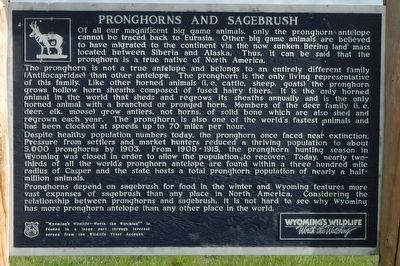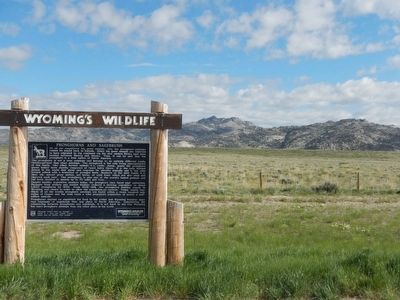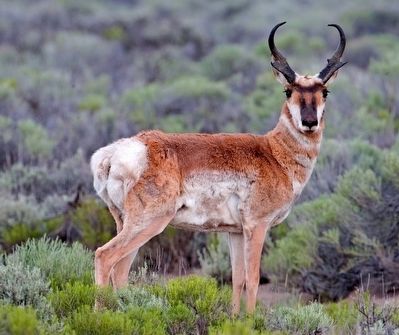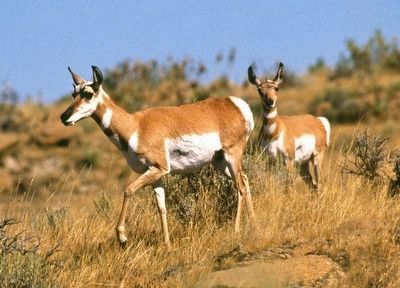Near Alcova in Natrona County, Wyoming — The American West (Mountains)
Pronghorns and Sagebrush
Wyoming's Wildlife
The pronghorn is not a true antelope and belongs to an entirely different family (Antilocapridae) than other antelope. The pronghorn is the only living representative of this family. Like other horned animals (i.e. cattle, sheep, goats) the pronghorn grows hollow horn sheaths composed of fused hair fibers. It is the only horned animal in the world that sheds and regrows its sheaths annually and is the only horned animal with a branched or pronged horn. Members of the deer family (i.e. deer, elk, moose) grow antlers, not horns, of solid bone which are also shed and regrown each year. The pronghorn is also one of the world's fastest animals and has been clocked at speeds up to 70 miles per hour.
Despite healthy population numbers today, the pronghorn once faced near extinction. Pressure from settlers and market hunters reduced a thriving population to about 5,000 pronghorns by 1903. From 1908-1915, the pronghorn hunting season in Wyoming was closed in order to allow the population to recover. Today, nearly two-thirds of all the worlds pronghorn antelope are found within a three hundred mile radius of Casper and the state hosts a total pronghorn population of nearly a half-million animals.
Pronghorns depend on sagebrush for feed in the winter and Wyoming features more vast expanses of sagebrush than any place in North America. Considering the relationship between pronghorns and sagebrush, it is not hard to see why Wyoming has more pronghorn antelope than any other state in the world.
Erected by Wyoming State Parks and Cultural Resources.
Topics. This historical marker is listed in this topic list: Animals.
Location. 42° 25.379′ N, 107° 15.955′ W. Marker is near Alcova, Wyoming, in Natrona County. Marker is on State Highway 220 near County Route 499, on the left when traveling east. Touch for map. Marker is in this post office area: Alcova WY 82620, United States of America. Touch for directions.
Other nearby markers. At least 8 other markers are within 3 miles of this marker, measured as the crow flies. Martin's Cove (approx. 1.1 miles away); a different marker also named Martin's Cove (approx. 2.6 miles away); Sun Ranch (approx. 2.7 miles away); Devil's Gate (approx. 2.7 miles away); A Tribute to Hardship (approx. 2.7 miles away); The Pioneer Women (approx. 2.7 miles away); The Oregon Trail (approx. 2.7 miles away); Tom Sun Ranch (approx. 2.7 miles away). Touch for a list and map of all markers in Alcova.
More about this marker. This marker is about 2.7 miles west of Tom Sun Ranch (Devil's Gate).
Also see . . . Pronghorn - National Wildlife Federation. Pronghorns are only found in North America. Their natural range extended from southern Canada to northern Mexico. Today, pronghorns are mainly found in the United States in the Great Plains, Wyoming, Montana, northeast California, southeast Oregon, Nevada, Utah, Colorado, Arizona and New Mexico. Some of the highest numbers of pronghorn are in Wyoming in the Red Desert and Yellowstone ecosystems. (Submitted on June 28, 2016, by Barry Swackhamer of Brentwood, California.)
Credits. This page was last revised on June 28, 2016. It was originally submitted on June 28, 2016, by Barry Swackhamer of Brentwood, California. This page has been viewed 522 times since then and 33 times this year. Photos: 1, 2, 3, 4. submitted on June 28, 2016, by Barry Swackhamer of Brentwood, California.



